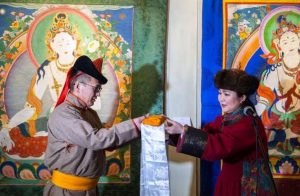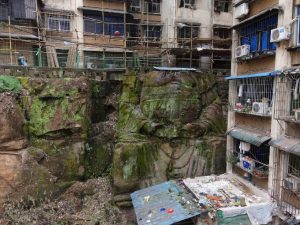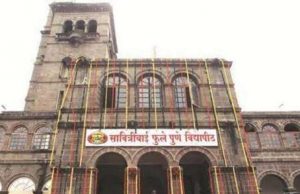
The issue of women’s empowerment in Tibetan Buddhism, especially for nuns, has been tenaciously resisted and debated about for almost 50 years. At the center the debate, we can find two closely intertwined issues: access for women to the highest level of Buddhist education—the geshema degree—and the restoration of full monastic ordination—gelongma or bhikshuni ordination.
The full ordination of the first Western nun, Freda Bedi, by Venerable Minh Chi and Venerable Sek Sai Chung in Hong Kong in 1972, revived the debate after 500 years of silence. The tradition of bhikshunis is believed to have never been introduced into Tibet in the Mulasarvastivada Vinaya tradition, and an ordination of bhikshunis by Tibetan monks alone—not a dual ordination—in the 15th century stirred up controversy. Full ordination for nuns survived in only one of the Buddhist Vinaya traditions, that of the Dharmaguptakas in the Chinese, Korean, and Vietnamese lineages.
It was not only Western nuns such as Freda Bedi and Tenzin Palmo (ordained in Hong Kong in 1973) who ordained. In 1971, Voramai Kabilsingh, a Thai woman and Theravada Buddhist, ordained in Taiwan. She was the first woman in modern history to take full ordination, and became stigmatized as the “Mahayana nun.”

In the late 1980s, His Holiness the Dalai Lama suggested that if full ordination of nuns was difficult to envisage in the Mulasarvastivada tradition, the schools could start by granting nuns access to higher philosophical studies, training them as geshes. His Holiness stressed this point by repeating “You will become geshema,” during his regular visits to Mundgod Jangchub Choeling Nunnery, which he inaugurated in 1987.
At first, this idea generated resistance and disbelief, but it had a deep impact on the lives of the nuns. Indeed, the 1980s were marked by the arrival of hundreds of exiled Tibetan nuns in Dharamsala, who initially required mainly humanitarian assistance, food, and shelter. Associations such as the Tibetan Nuns Project were founded for this purpose.
It was not until the early 1990s that further education was introduced in female monastic communities. Many nunneries began offering Buddhist philosophy studies and trained the nuns in philosophical debate. In 1995, the first inter-nunnery debating competition, or Jang Gonchoe, was organized. The Department of Religion and Culture (DRC) of the Central Tibetan Administration, based in Dharamsala, however, had no intention of bestowing geshe degrees on the nuns as none of them were fully ordained. The department even issued a letter prohibiting nuns from studying the Vinaya in full, preventing them from learning monastic discipline—an integral part of the geshe curriculum—even though some monk scholars were willing to teach them. As such, the nuns would never be able to meet the demands for the geshe degree, while monks could. Nevertheless, the nuns continued their studies and while their situation seemed to be in a stalemate, some of the nuns completed a prestigious program of 17 years of philosophical study.


Impressed and touched by the level of excellence of their philosophical debates, the Dalai Lama suggested once again in 2012 that the nuns of the Gelugpa tradition should be able to take the geshe examination. He created the title geshema specifically for this purpose, a female form of the title geshe previously non-existent in Tibetan Buddhism and therefore not dependent on the consent of the Gelugpa authorities.
In order to acquire the title, candidates need to pass four years of examinations—for male lharampa geshes the examinations take six years.
On 22 December 2016, 20 happy and deeply moved nuns, from six nunneries in India and Nepal, finally received their geshema degree from the hands of the Dalai Lama, beginning a new and historic chapter in Tibetan Buddhism.
The nun scholars, of course, are aware of the challenges that come with such a distinction. They will be called upon to teach monastics—monks as well as other nuns—and lay people, even though this was a role previously reserved for male geshes.
The geshemas will also have to assume greater responsibilities in their communities. On the occasion of the first geshema convocation, Namdol Phuntsok from Kopan Nunnery in Kathmandu, who graduated as one of the best of the 20 geshemas, paid homage to His Holiness for “his vision and his aspiration that enabled us to reach such a degree of studies.” The Dalai Lama, on his part, expressed hope that one day the nuns would stand at the head of their community as khenmo or abbess. But in order to take up such a position, nuns must be fully ordained.


Once again, the question of full ordination seems to play a large role in the progress of female empowerment in Tibetan Buddhism. Over the last 20 years, many Tibetan Buddhist masters—including many high lamas, geshes, and khenpos—led by His Holiness the Dalai Lama, have engaged in numerous discussions on this topic. During a meeting of Buddhist leaders and scholars of all traditions in Hamburg in July 2007, His Holiness stated: “We don’t need to discuss whether we should have bhikshunis or not, because this the Buddha has already decided on his own.” As Jetsunma Tenzin Palmo recalled, “The Buddha [already] praised the necessity of the fourfold sangha* for the flourishing of the Dharma in the world.”
In June 2015, the 12th religious conference of the four major schools of Tibetan Buddhism and the Bon tradition, organized by the DRC, decided that “Tibetan Buddhist novice nuns can decide on their own to take ordination in the Dharmagupta tradition,” conceding that “it is [at least] a reliable lineage.” But Ven. Jampa Tsedroen mentioned in the Journal of Buddhist Ethics: “It is unreasonable to expect the nuns who lack so much education to decide on their own how to go ahead!”
Perhaps the best option would be for the teachers or abbots of the nuns to encourage them—especially the geshemas who have faced similar challenges—to take full ordination in the Dharmagupta tradition. This will require long-term vision since Tibetan monks of other traditions have to know how to involve the nuns in their rituals, while belonging to a different Vinaya school. Not only they will have to empower the nuns, they will also have to decide how to integrate the nuns and their prescribed lifestyle into their own communities.
Since 2007, His Holiness Dalai Lama has repeatedly stated that “the issue is to find the way to ordain bhikshunis that is in accordance with the Mulasarvastivada Vinaya texts.” But during the First Geshema Convocation last December, he conceded that he did not want to impose his opinion and wanted to allow a democratic process to take place, especially when it came to the Vinaya issue. It will probably take quite some time to overcome the resistance that remains entrenched among senior clergy.

On 11 March 2017, another great figure of Tibetan Buddhism, His Holiness the 17th Karmapa, actively advocated bhikshuni ordination by inviting nuns from the Dharmagupta tradition, who came from Nan Lin Vinaya Nunnery in Taiwan, to give shramaneri (novice) vows in Bodhgaya to 19 nuns from six Kagyu nunneries. After a year of noviceship, a two-year traineeship would follow, starting with shikshamana (trainee) vows. And finally, in 2020, bhikshuni vows will be conferred to successfull candidates by a twofold sangha of 10 Mulasarvativada monks and 12 Dharmagupta nuns.
The Karmapa explained that he chose this form because he did not want to repeat history by making the same mistakes, so he decided on a different path than was taken a hundred years ago in Tibet. Ven. Bhikshuni Jampa Tsedroen provides us with the explanation: “The first approach, an ordination by [Mulasarvativada] bhikshus alone, no longer seems to be an option for him [because] at times when ordinations were given by monks only in the 13th–15th centuries, it led to harsh criticism.”
“Once we have bhikshunis, it will take another 10 years before they will be able to give anyone else the bhikshuni vows,” the Karmapa declared in March. “So this will take a long time, and I’ll be in my 40s when we get to the end of the process.” He added with honest conviction and devotion: “I found that the nuns’ pure intentions are so wonderful, really incredibly good. Sometimes I think we monks should be a little bit abashed at our intentions when we take vows as they are not nearly as fine or pure as theirs are. So I rejoice in what the nuns have done.”
With all the latest developments, there is no doubt that the day of nuns’ acceptance and emancipation is close. This is due to an increased awareness of their situation, which has really gained ground in Tibetan Buddhism. In the 1980s, it was taboo to speak about bhikshuni ordination, but now the number of people supporting ordination—including some members of the Tibetan government in exile—has grown significantly. This achievement can be attributed, above all, to the women’s involvement and their powerful energy. We can expect the 21st century to be theirs.
* The “fourfold” Sangha includes bhikkhus (monks), bhikshunis (nuns), upasaka (laymen) and upasika (laywomen).
Related news from Buddhistdoor Global
Twenty Tibetan Nuns Make History by Passing Geshema Degree
Related features from Buddhistdoor Global
Exclusive Interview: The 17th Karmapa and the Buddhist Nuns of the Tibetan Tradition
Beauty and the Feminine Buddhist Spirit in Spiti
Losar around Dharamsala
Peace Begins With Us
The Druk Amitabha Kung Fu Nuns: Combining Martial Arts and Meditation
Attending the Kalachakra











